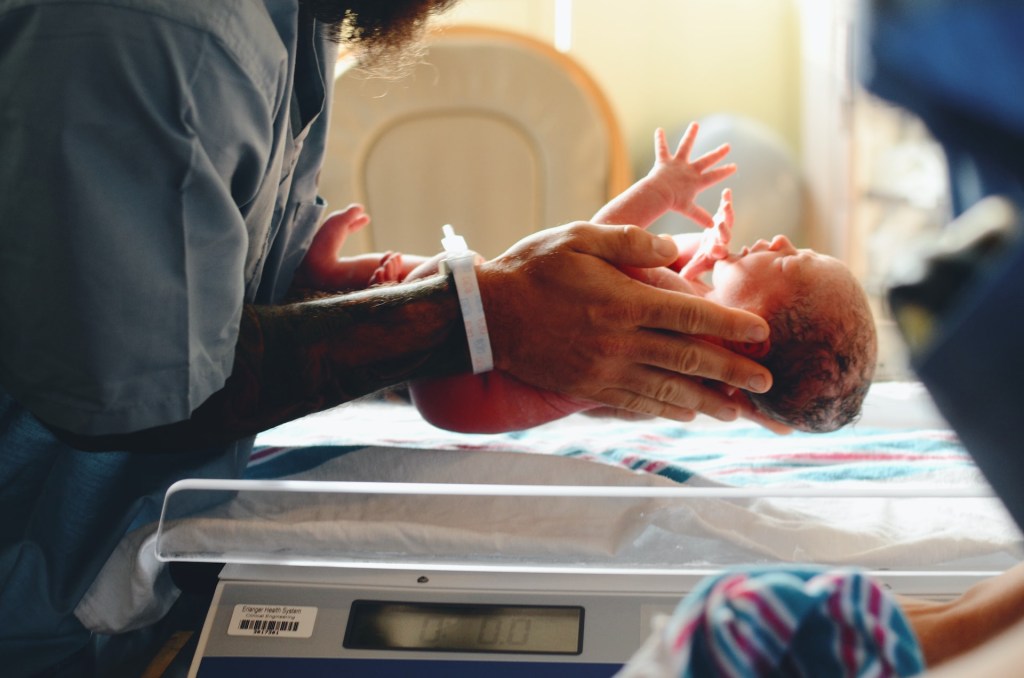Your cart is currently empty!
The 4 Stages of Labor

As you prepare for labor by nesting, packing a hospital bag, and getting as much rest as possible – you may be wondering what you can expect once labor actually begins. When we think of giving birth, our idea of what is coming is often skewed by representations in the media. Childbirth in movies is…
The Four Stages of Labor
When it comes to vaginal birth, there are four distinct stages that the body goes through.

Stage 1: Effacement & Dilation
This is the longest stage of the labor process. Effacement is when the cervix thins in preparation for birth. Dilation is the opening of the cervix, the entrance to the uterus. Stage 1 can be broken down into three phases.
1a. The Early Phase: This is the very beginning of labor. Your contractions can be up to 20 minutes apart. The frequency is not consistent and doesn’t have a pattern. Often, the contractions are mild, which makes this the perfect time to rest if you can.. Your cervix will dilate up to 6 centimeters, about the width of a soda can. Your baby begins moving down into position.
1b. The Active Phase: Your contractions become stronger, longer, and more frequent. At this point, you may need support from a partner, family member, or doula to get through them. Your cervix is dilating up to 8 cm, about the size of a baseball. You should head to the hospital, or call your midwife once your contractions are every 5 minutes, they last 1 minute, and have been following this pattern for at least 1 hour. This is known as the 5-1-1 rule. You can download an app or write in a notebook to keep track.
1c. The Transition Phase: This phase is short and intense. Contractions last about 90 seconds and come every 2-3 minutes. You will be completely effaced and the cervix will open up to 10 centimeters (About the size of a bagel). Your partner, doula, or nurse can help you find the most comfortable positions, as your body does this hard work. Your team will be closely monitoring both you and your baby’s heart rate.

Stage 2: Pushing & Birth
On average, this stage can last a few hours. This is when you work to bring your baby down through the birth canal, out of the vagina, and into the world. Several factors can impact this phase, including:
- The position of your body while pushing
- The position and size of your baby
- Whether or not you are medicated
- If this is your first birth
Contractions are now every 4-5 minutes, which allows you to rest a bit between each push. The end of this phase is marked by the birth of your baby! Your cord is cut and you get to have skin on skin bonding time with your newborn.

Stage 3: Delivery of the Placenta (Afterbirth)
During this stage, your doctor will be watching to see if your body is ready to release the placenta. You might feel some minor contractions again, which are signaling you to push the placenta out. If you don’t feel that urge, let your caretakers know and they will help you.
Once the placenta is released, your doctor will make sure it has been expelled entirely and check you for any tears that require repair.

Stage 4: Immediate Postpartum
During this time, your provider will be monitoring you for any postpartum complications. They will frequently check your uterus’ firmness, massaging it often to encourage it to contract and prevent postpartum hemorrhaging.
Some people experience tremors or chills in the hours after giving birth, warm blankets and rest can help. Your care team will provide ice packs to help with perineum pain and swelling. They will also offer options for pain relief and monitor your pain levels. Be sure to eat and drink to regain your strength (maybe some of those foods you have been missing so much!)
This is also when you get uninterrupted time to bond with your baby. If possible, start nursing within an hour of your baby’s birth. Babies are typically very alert during the first few hours of life, which makes this a great time to try breastfeeding. Ask for help from a caregiver or lactation consultant to start the first latch.
Make sure to also get all the freebies you can from the hospital before you leave. There are a bunch of postpartum essentials you’ll need for recovery, and you can likely get a lot of them for free upon discharge. Most hospitals offer a peribottle, heavy duty maxi pads, disposable mesh underwear, skin numbing spray, a sitz bath, donut pillow, breastfeeding supplies, baby wipes, diapers, pacifiers, and baby bottles. Don’t be shy and take everything you can get!












